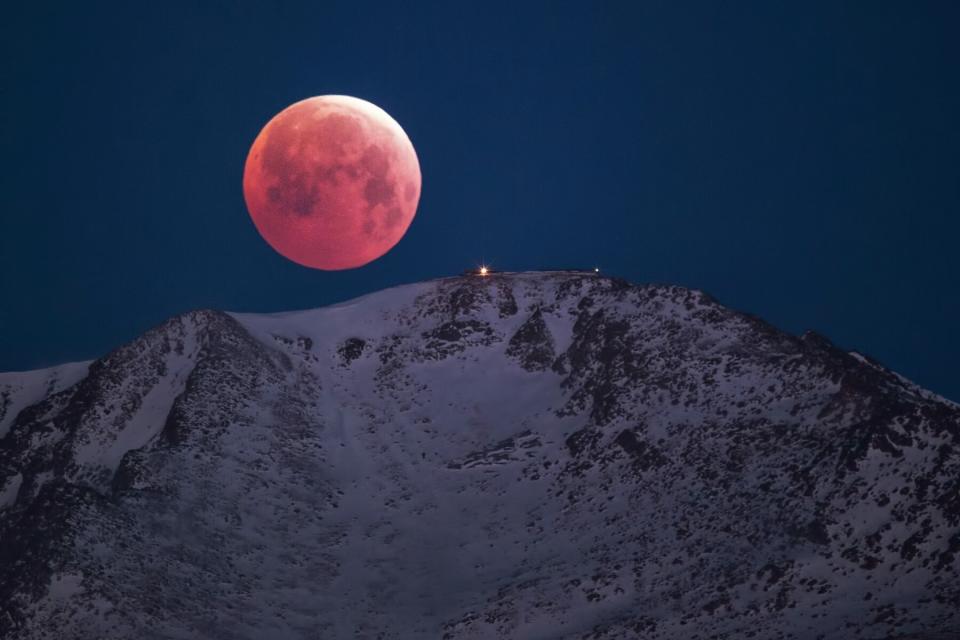How to See a Frosty Moon Eclipse and a Gorgeous Full Moonrise Next Week

If you've ever seen any kind of eclipse of the sun, you've stood in the shadow of the moon. But have you ever seen Earth's shadow on the moon?
That's exactly what's going to be possible in the early hours of Monday, Nov. 30, 2020 when the full Frosty Moon — also called a Beaver Moon — drifts into Earth's shadow in space.
Here's everything you need to know about the penumbral lunar eclipse visible from all of North America.
What is a penumbral lunar eclipse?
Earth always projects a shadow in space, but only when the sun, Earth, and moon line up — something astronomers called a syzygy — can a total lunar eclipse be caused. Another definition of that line-up is a full moon, which is the only time the sun is opposite the moon and so illuminates 100% of its surface as seen from Earth.
A full moon occurs every month, of course, but only occasionally is the syzygy so perfect that the moon moves into the Earth's shadow. In this case it's Earth's fuzzy outer shadow, its penumbra, that the moon will cross into. The visual effect will be of a gradual darkening of exactly 83% of the full moon, which will change from a bright, white orb in the night sky to a muted, dim grey object for a few hours. It's an odd sight and a great time to take a photo of our natural satellite.

Ivan Chistè/EyeEm/Getty Images
How rare is a penumbral lunar eclipse?
There have already been three penumbral lunar eclipses in 2020, with the Frosty Moon Eclipse being the fourth and final. However, the magnitude of each event hugely varies depending on how much of the Moon drifts into Earth's shadow. During the last one visible from North America – July 4's Thunder Moon Eclipse – only 35% of the moon was covered by the Earth. And the event was barely perceptible to the human eye.
During the Frosty Moon Eclipse, exactly 83% will be covered at the event's peak when the moon is closest to the center of Earth's shadow. So it should be much more noticeable.
When and where to see the Frosty Moon Eclipse
If you want to see the peak of the penumbral lunar eclipse, you're going to need to be in position at 9:42 Universal Time (UT), which is 4:42 a.m. EDT and 1:42 a.m. PDT on Monday, Nov. 30. That's when the shadowed full moon will be as eclipsed as it will get. However, the moon will begin drifting in to Earth's outer shadow at 7:32 UT before exiting at 11:53 UT.
If you're in EDT, that translates as 2:32 a.m. through 6:53 a.m. on Monday, Nov. 30. If you're in PDT, that's 11:32 p.m. on Sunday, Nov. 29 through 3:53 a.m. PDT on Monday, Nov. 30.
However, just as entrancing a sight will be of the full Frosty Moon appearing on the horizon at moonrise on Sunday, Nov. 29. The exact time of moonrise where you live depends on your location.
What happens after the Frosty Moon Eclipse?
Something wonderful. The exact celestial line-up that causes the moon to be perfectly placed at full moon to cause a lunar eclipse also means it will be in the right place two weeks at New Moon later to cause a total solar eclipse. One of nature's greatest events to experience, only those under a narrow "path of totality" through southern Chile and Argentina will experience two minutes and nine seconds of totality.
It's going to be a similar event to the 2017 eclipse in the U.S. minus the hordes of eclipse-chasers, most of whom won't see it because of COVID-19 travel restrictions.
When is the next blood moon?
The next total lunar eclipse – popularly known as a blood moon — will occur next year when on Wednesday, May 26, 2021 the whole of the full moon will drift in Earth's darkest central shadow in space. That will cause it to turn red because the only sunlight able to reach the lunar surface is first filtered by Earth's atmosphere, which only allows red light through (the science is the same for a sunset).
It's also going to be a supermoon, but will the Super Flower Blood Moon be an exciting event? Yes, but it will also be brief, with the moon turning reddish for only about 15 minutes. It will also only be viewable from parts of western U.S. as well as from western South America, Southeast Asia, and Australia.
The next blood moon total lunar eclipse for those in eastern U.S. will be on Sunday, May 15, 2022.

